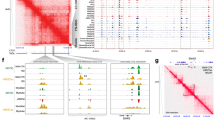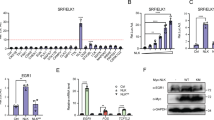Abstract
Expression of oncogenic Ras in 23A2 skeletal myoblasts is sufficient to induce both a transformed phenotype and a differentiation-defective phenotype, but the signaling pathways activated by oncogenic Ras in these cells and their respective contribution to each phenotype have not been explored. In this study, we investigated MAP kinase activity in control 23A2 myoblasts and in 23A2 myoblasts rendered differentiation-defective by the stable expression of an oncogenic (G12V)Ha-ras gene (Ras9 cells). The MAP kinase immunoprecipitated from Ras9 cells was 30 – 40% more active than that from control 23A2 cells. To establish if this elevated MAP kinase activity is essential to the maintenance of the oncogenic Ras-induced phenotype, we utilized the selective MAP kinase kinase 1 (MEK1) inhibitor, PD 098059. PD 098059 decreased the MAP kinase activity in Ras9 cells to the level found in 23A2 cells. PD 098059 did not affect the ability of 23A2 myoblasts to differentiate. PD 098059 reverted the transformed morphology of Ras9 cells but did not restore the ability of these cells to express the muscle-specific myosin heavy chain gene or to form muscle fibers. Treatment with PD 098059 also did not affect the ability of oncogenic Ha-Ras to establish a non-myogenic phenotype in C3H10T1/2 cells co-expressing MyoD. These results demonstrate that the activation of MAP kinase is necessary for the transformed morphology of Ras9 cells but is not required by oncogenic Ras to establish or to maintain a differentiation-defective phenotype. While these data do not rule out the possibility that constitutive signaling by MEK1 or MAP kinase could inhibit myoblast differentiation, they clearly demonstrate that other pathways activated by oncogenic Ras are sufficient to inhibit differentiation.
This is a preview of subscription content, access via your institution
Access options
Subscribe to this journal
Receive 50 print issues and online access
$259.00 per year
only $5.18 per issue
Buy this article
- Purchase on Springer Link
- Instant access to full article PDF
Prices may be subject to local taxes which are calculated during checkout
Similar content being viewed by others
Author information
Authors and Affiliations
Rights and permissions
About this article
Cite this article
Weyman, C., Ramocki, M., Taparowsky, E. et al. Distinct signaling pathways regulate transformation and inhibition of skeletal muscle differentiation by oncogenic Ras. Oncogene 14, 697–704 (1997). https://doi.org/10.1038/sj.onc.1200874
Received:
Revised:
Accepted:
Issue Date:
DOI: https://doi.org/10.1038/sj.onc.1200874
Keywords
This article is cited by
-
The myogenic kinome: protein kinases critical to mammalian skeletal myogenesis
Skeletal Muscle (2011)
-
Proto-oncogenic H-Ras, K-Ras, and N-Ras are involved in muscle differentiation via phosphatidylinositol 3-kinase
Cell Research (2010)
-
Delineating v-Src downstream effector pathways in transformed myoblasts
Oncogene (2008)
-
Increased expression of the pro-apoptotic Bcl2 family member PUMA is required for mitochondrial release of cytochrome C and the apoptosis associated with skeletal myoblast differentiation
Apoptosis (2007)
-
Insulin restores differentiation of Ras-transformed C2C12 myoblasts by inducing NF-κB through an AKT/P70S6K/p38-MAPK pathway
Oncogene (2002)



